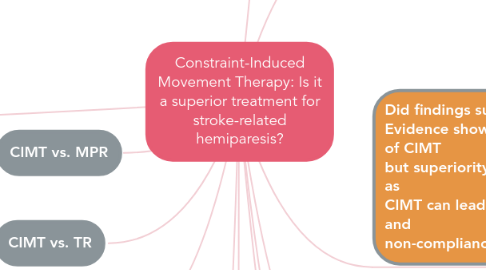Constraint-Induced Movement Therapy: Is it a superior treatment for stroke-related hemiparesis?
Tania Vicenteにより

1. Maintenance of progress 3-months post-treatment
1.1. Outcome measures maintained at post-testing
1.2. Outcome measures higher at follow-up suggesting continued improvements even after treatment
2. Take home message: Treatments for hemiparesis, including CIMT, should be designed to meet the needs of each patient specifically to increase the chance of recovery and decrease risk of further injury. Just as the OT framework states, delivery of services should be client-centered.
3. Views on 2 stroke-survivors post-treatment
3.1. Both motivated at start of treatment
3.2. Participant Chris found it difficult to complete
3.3. Participant Janice did not think improvement was significant
4. Standpoint of 3 men post-treatment
4.1. All 3 participants motivated to get better
4.2. CIMT caused muscle pain, soreness and stiffness
4.2.1. Does CIMT cause secondary health problems?
4.3. All 3 participants found program difficult
5. CIMT vs. MPR
5.1. CIMT demonstrated increased scores in comparison to MPR
5.2. Look into: intensity of each program
6. CIMT vs. TR
6.1. Both treatment groups had positive outcomes; which scored higher?
6.2. CIMT demonstrated decreased spasticity at follow up
7. Typical CIMT protocol involves constraining the "good" extremity for 90% of waking hours in order to teach the "weak" extremity to regain function. This requires the need of family support in the home in order to safely complete functional tasks.
7.1. Patients may feel frustrated and depressed due to further decline in independence from constraining their only good extremity.
8. Effect on the elderly population
8.1. Motor changes occurred 2/4 participants maintained progress at follow up testing
8.2. One participant stopped treatment due to rigorous protocol
9. Maintenance of progress 4 and 5-years post-treatment
9.1. All participants demonstrated maintenance of progress at 4 and 5-year mark
9.2. One participant had to retire from employment due to fatigue caused by CIMT
10. CIMT vs. bilateral treatment
10.1. Both caused motor changes rendering both viable treatment options
10.2. Bilateral treatment higher scores at follow up testing
11. Did findings support thesis? Evidence shows effectiveness of CIMT but superiority is questionable as CIMT can lead to over use injury and non-compliance
11.1. Overuse injury is possible as patient is forcing 1 extremity to complete tasks for 90% of their waking hours. This extremity already presents with increased weakness, decreased coordination and dexterity, the risk for overuse injury is possible.
11.2. Overuse injury is known as stress caused by repetitive movements/motions
12. Recommendation: Further research is required with larger sample groups as most studies conducted are on small test groups
12.1. Recommendation: Research should focus on determining if modification of a program to constrain the extremity for shorter periods over a longer timeline is effective. Typical protocol involves constraining good extremity for 90% of waking hours a day for 2 weeks. Research should focus on simulating a typical rehabilitative environment with incorporation of a feasible home exercise program by limiting the hours a patient has to keep the good extremity constrained.


